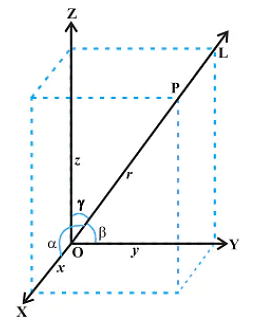Let the plane
\(P : \stackrel{→}{r} . \stackrel{→}{a} = d\)
contain the line of intersection of two planes
\(\stackrel{→}{r} . ( \hat{i} + 3\hat{j} - \hat{k} ) = 6\)
and
\(\stackrel{→}{r} . ( -6\hat{i} + 5\hat{j} - \hat{k} ) = 7\)
. If the plane P passes through the point (2, 3, 1/2),
then the value of \(\frac{| 13a→|² }{d²}\) is equal to
Let the plane
\(P : \stackrel{→}{r} . \stackrel{→}{a} = d\)
contain the line of intersection of two planes
\(\stackrel{→}{r} . ( \hat{i} + 3\hat{j} - \hat{k} ) = 6\)
and
\(\stackrel{→}{r} . ( -6\hat{i} + 5\hat{j} - \hat{k} ) = 7\)
. If the plane P passes through the point (2, 3, 1/2),
then the value of \(\frac{| 13a→|² }{d²}\) is equal to
- 90
- 93
- 95
- 97
The Correct Option is B
Solution and Explanation
The correct answer is (B) : 93
P1: x + 3y – z = 6
P2: –6x + 5y – z = 7
Family of planes passing through line of intersection of P1 and P2 is given by x(1 – 6λ) + y(3 + 5λ) + z (–1 – λ) – (6 + 7λ) = 0
It passes through (2, 3, 1/2)
So,
\(2 ( 1 - 6λ ) + 3(3 + 5λ) + \frac{1}{2} (-1 - λ) - ( 6 + 7λ ) = 0\)
\(⇒ 2 - 12λ + 9 + 15λ - \frac{1}{2} - \frac{λ}{2} - 6 - 7λ = 0\)
\(⇒ \frac{9}{2} - \frac{9λ}{2} = 0 ⇒ λ = 1\)
Required plane is
–5x + 8y – 2z – 13 = 0
Or
\(\stackrel{→}{r} . ( -5\hat{i} + 8\hat{j} - 2\hat{k} ) = 13\)
\(\frac{| 13a→ |²}{ |d|²} = \frac{13²}{(13)²} . |\stackrel{→}{a}|^2 = 93\)
Top Questions on Three Dimensional Geometry
- If A(2,1,-1), B(6,-3,2), C(-3,12,4) are the vertices of a triangle ABC and the equation of the plane containing the triangle ABC is $53x+by+cz+d=0$, then $\frac{d}{b+c}=$
- TS EAMCET - 2025
- Mathematics
- Three Dimensional Geometry
- If $(\alpha, \beta, \gamma)$ is the foot of the perpendicular drawn from a point $(-1,2,-1)$ to the line joining the points $(2,-1,1)$ and $(1,1,-2)$, then $\alpha+\beta+\gamma=$
- TS EAMCET - 2025
- Mathematics
- Three Dimensional Geometry
- If m:n is the ratio in which the point $\left(\frac{8}{5}, \frac{1}{5}, \frac{8}{5}\right)$ divides the line segment joining the points (2,p,2) and (p,-2,p) where p is an integer then $\frac{3m+n}{3n}=$
- TS EAMCET - 2025
- Mathematics
- Three Dimensional Geometry
- Let $\pi_1$ be the plane determined by the vectors $\hat{i}+\hat{j}, \hat{i}+\hat{k}$ and $\pi_2$ be the plane determined by the vectors $\hat{j}-\hat{k}, \hat{k}-\hat{i}$. Let $\vec{a}$ be a non-zero vector parallel to the line of intersection of the planes $\pi_1$ and $\pi_2$. If $\vec{b} = \hat{i}+\hat{j}-\hat{k}$ then the angle between the vectors $\vec{a}$ and $\vec{b}$ is
- TS EAMCET - 2025
- Mathematics
- Three Dimensional Geometry
Show that the following lines intersect. Also, find their point of intersection:
Line 1: \[ \frac{x - 1}{2} = \frac{y - 2}{3} = \frac{z - 3}{4} \]
Line 2: \[ \frac{x - 4}{5} = \frac{y - 1}{2} = z \]
- CBSE CLASS XII - 2025
- CBSE Compartment XII - 2025
- Mathematics
- Three Dimensional Geometry
Questions Asked in JEE Main exam
- A group 15 element forms \( d\pi - d\pi \) bond with transition metals. It also forms a hydride, which is the strongest base among the hydrides of other group members that form \( d\pi - d\pi \) bonds. The atomic number of the element is ________________________.
- JEE Main - 2025
- Chemical bonding and molecular structure
- The value of \( (\sin 70^\circ)(\cot 10^\circ \cot 70^\circ - 1) \) is:
- JEE Main - 2025
- Trigonometric Identities
- Match List-I with List-II.

- JEE Main - 2025
- Dimensional analysis
Nature of compounds TeO₂ and TeH₂ is___________ and ______________respectively.
- JEE Main - 2025
- Inorganic chemistry
- Let \( A = [a_{ij}] \) be a matrix of order 3 \(\times\) 3, with \(a_{ij} = (\sqrt{2})^{i+j}\). If the sum of all the elements in the third row of \( A^2 \) is \( \alpha + \beta\sqrt{2} \), where \(\alpha, \beta \in \mathbb{Z}\), then \(\alpha + \beta\) is equal to:
- JEE Main - 2025
- Matrices and Determinants
Concepts Used:
Three Dimensional Geometry
Mathematically, Geometry is one of the most important topics. The concepts of Geometry are derived w.r.t. the planes. So, Geometry is divided into three major categories based on its dimensions which are one-dimensional geometry, two-dimensional geometry, and three-dimensional geometry.
Direction Cosines and Direction Ratios of Line:
Consider a line L that is passing through the three-dimensional plane. Now, x,y and z are the axes of the plane and α,β, and γ are the three angles the line makes with these axes. These are commonly known as the direction angles of the plane. So, appropriately, we can say that cosα, cosβ, and cosγ are the direction cosines of the given line L.
